F1 Car Set up
What values to choose when setting up your car.
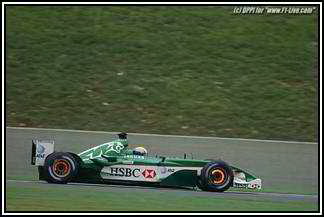
Contents:
1: Gears
2: Mechanical and aero
2.0 Brake duct size
2.1 Engine rev limit
2.2 Radiator size
2.3 Steering lock
2.4 Differential lock
2.5 Wing
2.6 Anti-roll bars
2.7 Weight distribution
2.8 Brake pressure
2.9 Brake bias
3: Tire pressure and camber
3.0 Camber and toe in
3.1 Tire pressure
4: Springs and ride height
4.0 Ride height
4.1 Packers
4.2 Springs
5: Bump and rebound dampening
5.0 Rebound dampers
5.1 Bump dampers
6: Car setup questions
1 Gears.
How do I setup my gear ratios?
The faster the track the higher gear ratio you will need.
The slower the track the lower the gear ratio you need.
This is gearing for Australia.
The track has short straights and lots of corners therefore good acceleration is required and top speed is not as important.
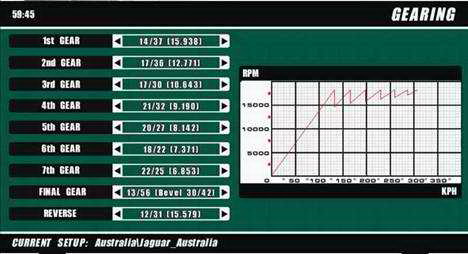
The first gear should be set to best suit the slowest corner; while the top gear should allow you top speed without over-revving the engine.
The final gear in this image is the lowest. There are three levels of final gear.
Low: The lower the final gear the more potential your car has for acceleration, but will not be so fast at high speeds
Medium: The middle final gear is a blend of Low and High final gear.
High: The higher the final gear the greater potential your car will have at high speeds but will have a slow acceleration.
When you alter your car setup, wing, radiator size, brake duct size etc, you will need to adjust your gears to accommodate the speed gained or lost.
2 Mechanical and Aero

2.0 Brake Duct Size
What brake duct size should I have?
You should choose the brake duct based on the amount you brake, your brake pressure and the type of track. Generally 2 is a good size.
The higher your brake duct size the slower your car will go.
You need a balance between brake temperature and speed.
If you brake late into the corners you will need more brake cooling a higher brake duct.
If you brake early and less frequently then you should have a brake duct size of 1
2.1 Engine Rev Limit
Set this as high as you can, default setup normally leaves room for increasing the rev limit.
2.2 Radiator Size
What radiator size should I use?
You should generally use a radiator size of about 3. The longer your car is at the top of each gear, the more cooling it will need and the higher the radiator size you will need. If the server has mechanical failures off, then set your radiator size to 1.
2.3 Steering Lock
What steering lock is best?
You should choose the lowest steering lock that will allow you to get around the tightest corner most comfortably.
Choosing a lower steering lock will stop you from turning the wheel too far and wearing out the tire.
For Monza you probably want a low steering lock, closer to 18, for Monaco you will want the maximum steering lock for all the tight corners.
2.4 Differential Lock
What is diff lock?
The differential lock allows the outside wheels to spin faster than the inside wheels.
100% lock will force the outside wheels to spin the same speed as the inside wheels since the wheels will be locked
90% lock will allow 10% of the power (torque) to be shifted from the inside wheel to the outside wheel.
0% lock will allow 100% of the power to be shifted from the inside wheel to the outside wheel (Youll find racing with 0% diff lock will cause severe over steer)
You should choose as lower percentage diff lock as you can while keeping the car controllable through the corners. A higher diff lock will also make it easier to ride the curbs.
2.5 Wing
The higher your wing the slower your car will go because of the drag created from the down force.
You need to find a balance between speed on the straights and down force to get around the corners.
Generally if the track is very windy then you are going to need more wing.
More front wing than rear wing will allow over steer and let you corner better.
Front wing carries much less down force than rear wing, so 50 front wing will not slow you down as much as 50 rear wing.
Downforce Classification:
Low: <35 wing Medium: >35 wing < 43 wing High: >43 wing
Tracks and the downforce needed:
Australia - medium to high (42/38)
Malaysia - medium
Brazil - medium to high (45/39)
Imola(san marino)- medium to high (47/43)
Catalunya - medium
Austria - medium to high (43/40)
Monaco - high (50/50)
Gilles Villeneuve - medium to high (47/40)
Nurburgring - medium to high (46/40)
Magny Cours - medium to high (45/40)
Silverstone - medium (45/35)
Hockenheim old - low (35/28)
Hockenheim new - high (50/45)
Hungaroring - high (50/45)
Spa - medium (40/35)
Monza - low (38/31)
Indianapolis - medium or medium to high
Suzuka - medium to high (45/39)
2.6 Anti-roll bar
The anti roll bar will limit the roll as your car goes through the corners
A higher number (200) for front anti-roll will allow both front wheels to stay on the ground to provide traction.
A high anti-roll bar will provide more speed but less grip.
A low anti-roll bar will let the car roll in the corner more, if the front anti-roll is quite low (100) then the front inside wheel may lift off the track when cornering, but more weight will be on the outside wheel and more weight on the outside wheel means more grip until the wheel becomes overloaded (too much weight transfer) and the car spins out.
Because more weight is transferred forward when you brake to corner, a lower rear anti-roll can safely be used, a higher number like (100) for rear anti-roll will keep the ass-end on the ground better but less weight will transfer to the outside of the car to give more grip around a corner, using a low number like (50) for rear anti-roll will let more weight transfer to the outside wheel and provide more grip but the inside wheel may lift off the ground and less traction will be provided.
2.7 Weight Distribution
While shifting the weight forward will provide more grip and easier cornering, it may unbalance the rear of the car.
Shift your weight as far forward as you can without causing unbalancing in the rear of the car.
If the car loses grip in the rear because you have shifted the weight too far forward, try increasing rear anti-roll, softening the rear suspension (softer rear suspension releases the energy slower and stops you spinning out when the rear of the car unloads under braking into a corner) or adding more rear wing.
2.8 Brake Pressure
A higher brake pressure will let you brake into corners later and provide more overtaking opportunities but at the expense of more cooling required to stop the brakes from overheating (a higher brake duct size).
A higher brake pressure will make you more likely to lock your wheels when braking without ABS.
A lower brake pressure will let you have a smaller brake duct so you can gain more speed on the straights.
2.9 Brake Bias
The lighter your car the less brake bias you need towards the front of the car since less weight is transferred forward under braking.
60:40 is a good bias to use and 63:37 is good when you have a heavy fuel load or are braking very hard into corners.
You should adjust your brake bias forward when you are full of fuel so that when you brake into corners more brake pressure is applied at the front where more weight will be being transferred.
Stiff rear suspension (around 140) means you will need more brake bias towards the front of the car since the weight unloads off the rear of the car faster and more weight shifting towards the front of the car faster means the front wheels will need more brake pressure.
3 Tire Pressure and Camber
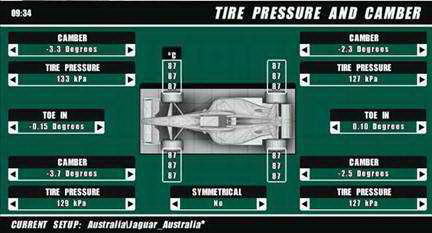
3.0 Camber and Toe In
Camber is the amount the wheel is angled in or out vertically.
Negative camber means the wheel will lean inwards.
Positive camber means the wheel will lean outwards.
More negative camber means you can corner better, as the car goes into a corner and weight is transferred onto the tire, the tire is pushed down onto the track.
Generally more negative camber will help you go around a corner faster.
Too much negative camber will cause your tires to overheat, while you are getting more grip out of the tires, the tires are working harder and toasting themselves.
The softer your suspension, the more negative camber you will need.
You should have about 0.2 less negative camber on the inside wheels as they stay carry less weight than the outside wheels. If the track goes clockwise your inside wheels will be the right hand side of the car, if the track goes anti-clockwise your inside wheels will be on the left of the car.
Toe is the amount the wheel is angled horizontally.
Negative toe means the wheels are pointing inwards.
Positive toe means the wheels are pointing outwards.
Too much toe in can cause the outside of the tires to get too hot, but also slow the car down since the wheels arent quite pointing straight.
Toe in will help you keep the car in a straight line.
What camber should I use?
It depends on how soft your suspension is and how much you allow your car to roll (anti-roll).
The softer your suspension the more camber you will need
The less anti-roll you have the more camber you will need.
Some camber examples for different tracks:
Silverstone: -3.2 / -2.2
Monza: -2.5 / -1.9
Spa: -2.6/ -2.
Austria -2.5/-1.8
Australia -3.5/-2.5
Magny Cours -3.2/-2.1
Imola -3.5/-2.4
Suzuka -3.8/-2.4
Nurburgring -3.0/-2.1
The longer you run your tire, the less negative camber you should use, these camber numbers are for running tires on about 15-20 lap stints at 1x tire wear.
3.1 Tire Pressure
Your tire pressure should be adjusted so the temps are even over the tire, you will not normally get an even temperature over the tire.
The inside should be about the same as the middle of the tire, and its ok if the outside of the tire is cooler (it will heat up going round the corners)
Lowering your tire pressures will deflate the tire and stop the crown (the middle) of the tire overheating.
Lowering your tire pressures will also allow the tire to heat up more.
Always complete about 3 laps before you look at your tire temps, if you do not, then you will have inaccurate tire temps.
4 Springs
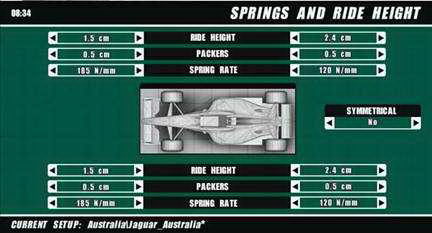
4.0 Ride height
The ride height should generally be set as low as possible without causing the cars plank to scrape on the track for an extended period.
The bumpier the track the higher the ride height you will need.
The softer your suspension (springs) the higher the ride height you will need.
The lower your ride height the greater the suction (thus more grip) under the car.
Plank wear is nothing to worry about in f1 Challenge, but in real life, the planks are 1 cm thick, and if the plank wears more than 1 millimeter then the car is disqualified.
What ride height should I use?
For most tracks 1.7 front ride height and 2.9 rear ride height will be about what you want.
On Magny Cours you can have a very low ride height like (1.5 / 2.2) without scraping the cars plank. This is because Magny Cours is very flat and has no large bumps.
On tracks where you need to ride curbs to get good times like Imola (San Marino) you might need a higher ride height like (2.5/3.5).
Low ride height on bumpy tracks like Brazil is not always best since it limits the suspensions ability to soak up the bumps and let the car get through corners smoothly.
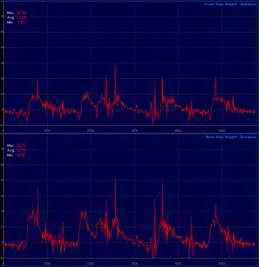
You can see in the image above that the ride height is quite low, this is on Monza. The ride height decreases as the car gets faster and is sucked down onto the track and finally at the braking points the car briefly bottoms out, but a small amount of bottoming out is ok. If you have lots of space under your graphs for ride height you should lower your car. Sudden spikes are usually when curbs are hit; in this case you should ignore the spikes.
4.1 Packers
Packers limit the suspension travel by providing a stopper when the suspension bottoms out. This means that if you have soft suspension a packer would stop your car bottoming out.
How much packer should I use?
About .8 on the front and about 1.0 on the rear for most tracks.
On Spa-Francorchamps you will probably want higher packer like 2.0 since the track is bumpy and has contours. Eau Rouge is also a very nasty corner.
4.2 Springs
Springs are basically how soft or stiff your suspension is.
Springs determine the amount the car will pitch.
Hard springs (200 / 150) will mean the car will not pitch much so you can have a much lower ride height.
Hard springs make the car a lot more responsive but the car will not handle very well through corners.
Soft springs will allow the car to go through corners a lot more easily, but the car will be harder to drive because it will be less responsive.
Hard springs release their energy faster than soft springs, but hard springs absorb energy slower than soft springs.
Soft springs will provide more grip but will cause more tire wear and cause the tire to heat up more.
You can affect how the front of the car behaves by adjusting rear suspension.
If your car is unstable into a corner under braking, instead of making the front stiffer, soften the rear so that the softer springs can release the energy slower.
How do I decide what stiffness of spring to use?
The more windy the track the softer you will want your springs as your car will corner better with softer springs.
You will need stiffer front springs if you want to ride the curbs a lot.
On a track with not so many corners like Monza you can use stiff springs (190 / 140) because cornering is not as much of an issue, you also get to lower your ride height because the car will be less bouncy and scrape the track less often.
You should always have stiffer front springs than rear springs.
Softer rear springs will provide more grip and reduce wheel spin in the rear of the car.
On a track where you dont need to ride the curbs much (like Monaco) then you can have soft springs (130/90), but you have to balance it between responsiveness and tire temperature.
On Australia (185 /120) is good, the stiffer front lets you cut the corners over the curbs without disturbing the balance of the car because the bumps are absorbed more slowly but the suspension resets fast enough that the car isnt unbalanced very long.
If you are spinning out while hitting curbs you probably want your front suspension at about 180-190.
Spinning out can also be because your rear suspension might be too high, a setting of 110 on most tracks will stop the rear unloading too fast and causing a spin.
Dont forget after adjusting springs to watch your tire temperature and then adjust the camber afterwards.
Stiffer springs = less negative camber needed.
Softer springs = more negative camber needed.
5 Dampers
The dampers should be the last part of your car setup to complete, they are fine adjustments and dont affect the car in a very big way.
While the springs affect the amount the car pitches, the dampers affect the rate at which that pitch occurs.
Fast and slow dampening is the speed at which the wheel moves up or down.
Fast dampening fine-tunes the cars handling over bumpy surfaces.
Slow dampening fine-tunes the cars handling around a corner.
If your car is not handling well over bumps then bump and rebound dampening is the thing to change.
A stiffer damper will give better cornering stability.
A softer damper will give better cornering grip.
5.0 Bump dampers are concerned with ride height decreasing (when the wheel goes up)

5.1 Rebound dampers are concerned with ride height increasing (when the wheel goes down)
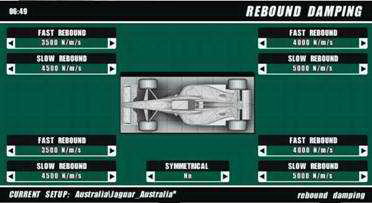
In the telemetry for dampers, you can see spikes. You can flatten these spikes out by softening the dampers (a lower value). When the graph is negative it is bump dampening, the positive part of the graph is rebound dampening. You can see on this graph that the rebound dampers are slightly stiffer than the bump dampers since the min and max averages are 47.59 and 43.76. It is better to have stiffer rebound than bump dampening.
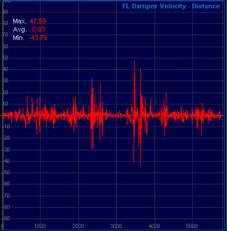
What values for the dampers do I need?
It is usually very hard to tell what damper settings you should have but in any case it only has a small effect on the cars handling.
If you know that your car is unstable through the corners then you probably want to stiffen the dampers (increase the values).
If your car needs more grip through the corners then you probably want to soften the dampers (decrease the values).
6.0 Car setup questions
Making your car corner better
Why does my car over steer and spin out when I go through corners?
Your differential lock might be too low. Try increasing the diff lock percentage.
Try softening your rear suspension.
Why does my car over steer when I brake into the corner?
Your differential lock might be too low. Try increasing the diff lock percentage.
You might want to try softening the rear suspension.
Why does my car under steer when I go into corners?
You differential lock could be too high. Try lowering the diff lock enough that it still gives you control without over steering on braking or corner entry.
How do I stop my car spinning when I hit the curbs?
You might need to stiffen your front suspension and soften the rear suspension, this will cause the energy to be sent to the rear of the car and absorbed by the softer rear suspension, allowing the front of the car to stay balanced.
You may want to increase front and rear anti-roll to keep the car more stable over the curb.
Making your car faster
How do I get more speed out of my car
Lower your wing, but you must balance your wing between gaining speed on the straights and gaining speed on the corners.
For more cornering speed, you need more grip on your tires. Soften your suspension (springs) and dampers; decrease anti-roll, Increase negative camber.
Lowering your car will increase your speed.
Making your car more stable
My car is unstable through the corners how to fix?
Stiffen your springs and dampers.
Increase your anti-roll to limit the load on the outside tires through a corner
Shift some weight towards the rear of the car
Soften the rear suspension.
Increase the diff lock.
Increase the wing.
My car spins out on corner entry
Your rear springs might be releasing the load too fast, try softening the rear springs
You may have to adjust your brake bias, if the rear is letting go, it probably needs more brake pressure, adjust brake bias towards the rear.
Your diff lock could be too low and power is being taken off the inside wheels too soon when you brake. Increase diff lock
Your front anti-roll may be too low, try increasing front anti-roll to stop the car turning in so suddenly.
Your rear anti-roll may be too low, try increasing rear anti-roll to keep traction on both the rear tires.
Tire temperatures
How do I get my tire temperatures even?
If the crown (center) of your tire is too hot then you might want to lower the tire pressure. Lowering the tire pressure will also cause the tire to heat up more
If the inside of the tire is too hot then you probably need to stiffen your springs or decrease negative camper.
If the outside of the tire is too hot then you will need to add negative camber and/or make the springs softer.
If your inside tires are too cool and your outside tires are too hot then try adding more anti-roll to keep more weight on the inside tires while cornering.
How do I stop my front tires from being toasted?
Stiffen your front suspension or soften your rear suspension
Decrease negative camber.
Increase the tire pressure.
Spread the load between the front 2 tires if 1 of them is being toasted by increasing the front anti-roll bar.
You may be steering too hard around the corners and scraping the tires along, try lowering your steering lock.
How do I stop my rear tires from being toasted?
Usually your rear tires heat up if the suspension is too soft and the tires are providing more grip.
Lowering the rear wing will take stress off the rear tires.
Spread the load between the rear tires by increasing your rear anti-roll.
Have a look at your wheel spin graph, if the graph goes positive it means the wheel is spinning faster than it should be. Softening the rear suspension will provide more grip and will help avoid wheel spin.
Softening the rear suspension will stop the tires heating up if you are getting positive wheel spin.
Softening the rear suspension will provide more grip and may cause the tires to heat up you need to look at your wheel spin graph to decide.